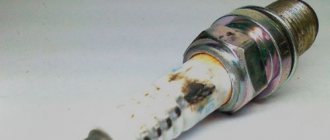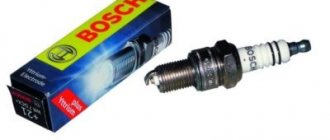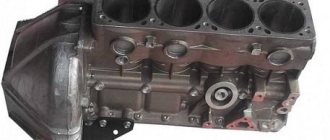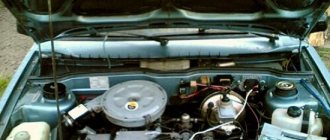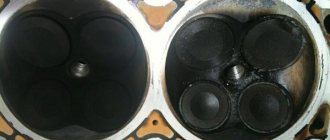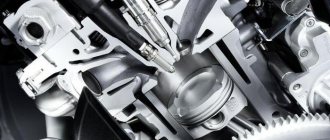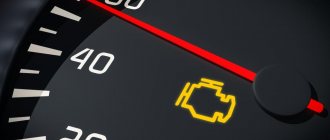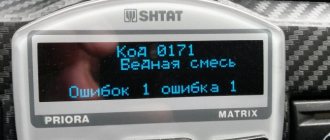Technical characteristics and device
Before moving directly to the consideration of the reasons why the engine is tripping, as well as to the solution methods, let’s consider the main technical characteristics of the power unit. As practice has shown, the power unit has fairly high technical characteristics, and therefore is loved by many motorists.
The simple design and reliability made the engine widespread among Gazelle car owners. Let's consider the main technical characteristics of the power unit:
| Name | Characteristic |
| Type | Row |
| Fuel | Petrol |
| Injection system | Injector |
| Volume | 2.9 liters (2890 cm3) |
| Power | 123 horsepower |
| Number of cylinders | 4 |
| Cylinder diameter | 100 mm |
| Consumption | 11 liters per 100 km |
| Cooling system | Liquid, forced |
| Econorm | Euro-3 |
This type of engine was used in Gazelle Business and Next vehicles.
Causes of engine tripping
Any engine tends to break down. Thus, the UMZ 4216 E-3 is also susceptible to malfunctions. In this article, we will look at why the power unit is tripping, as well as methods for diagnosing and treating this malfunction. Perhaps most car enthusiasts have encountered this problem and know how to fix it.
So, let's look at what elements of a car engine can lead to the power unit starting to trip:
- Poor quality fuel.
- Sensor malfunction.
- Fuel system malfunction.
- It's all because of the air.
- The problem is the ignition.
- The valves and piston are a problem.
- ECU.
The engine stalls when hot: causes and common faults
Let's start with the main features. Often, a cold engine starts quite normally, but then begins to stall after partial warming up or completely reaching operating temperatures. In this case, tripping can occur both at idle and under load (while driving).
- You should start by checking the control system (ECM) and the engine power system. It is recommended to immediately carry out computer diagnostics and check the condition of the injector and injectors.
In any case, incorrect readings or malfunctions of sensors (lambda probe, temperature sensor, mass air flow sensor, etc.) and actuators can cause a hot engine to fail. Based on incorrect readings, the ECU may well over-enrich the working fuel-air mixture and flood the spark plugs.
- Next you need to move on to the spark plugs. At the initial stage, you should remove the spark plug high-voltage wires and unscrew the spark plugs from the BC. Next, a visual inspection of their contacts and insulators is carried out. Normally, candles should be dry, grayish in color, without a heavy layer of soot.
If the spark plug is wet and/or oily, then it is quite obvious that too much engine oil is entering the combustion chamber or the fuel is not being burned in the cylinder. In any case, a wet spark plug does not allow the cylinder to operate normally. Let us add that often both causes are often present simultaneously or are a consequence of each other.
If all the spark plugs are wet, you should check the oil level in the internal combustion engine. When the level is elevated (often as a result of overflow), the oil pressure in the lubrication system after the engine warms up exceeds the norm, excess lubricant penetrates the combustion chamber and contaminates the spark plugs. The result is a weak spark.
You also need to check the crankcase ventilation system. For example, the breather hose may become kinked, contamination may occur, etc. The main thing is that problems with this system also lead to pressure rising and excess oil entering the cylinders. If the hot vibration disappears after pumping out excess oil and cleaning the crankcase ventilation system, we can talk about a successful solution to the problem.
If this does not help, the spark plugs themselves will require increased attention. It is likely that even if the spark plugs have recently been changed, they will turn out to be incorrectly selected for the engine in terms of heat rating and will be “cold”; also, the spark plugs may simply fail or the product will be defective. To check, you need a kit that is known to be working (it is better if the spark plugs were removed from another car). If the engine does not start in these sections after warming up, then the spark plugs need to be replaced.
If it turns out that the dry spark plug in the cylinder has become wet, then it is worth checking the high-voltage ignition wire of a particular cylinder. The wire needs to be replaced with a working one. Also note that the problem may not be in the wires. For example, on carburetor internal combustion engines, a common cause of ignition problems is the distributor (ignition distributor).
On injection engines, failures can result from breakdowns of the ignition coils. In the case of a distributor, the device must be disassembled, dried, cleaned the contacts and made the necessary adjustments. If we are talking about an engine with an injector, you can swap the ignition coils and wires. This method allows you to quickly identify a faulty coil.
Troubleshooting methods
Once the root causes have been identified, troubleshooting can begin. Before we begin, it is worth noting that not all motorists are able to understand and fix the problem. So, it is necessary to have certain knowledge in the design of cars, as well as be able to diagnose correctly.
Therefore, it is strongly recommended that if a car enthusiast is not confident in his abilities, he should contact a specialized car service center, where professional workers can quickly and efficiently fix the problem. Well, those who decide to try it themselves should be patient.
Poor quality fuel
The power unit is malfunctioning, most likely due to low-quality fuel that has clogged the entire system. So, to solve the problem it is necessary to clean the entire fuel line and fuel tank. It is also recommended to check the injectors and fuel filter. After repairs, fill only with high-quality fuel at proven fuel stations.
Sensor malfunction
Another common problem is faulty engine sensors. Thus, the output of one or more measuring elements can lead to the motor starting to trip, which is very unpleasant. In this case, an increase in consumption will be observed. Therefore, to diagnose meters, it is worth stocking up on a multimeter, with the help of which the performance of the elements will be determined.
So, let's look at which sensors will affect engine operation:
- The first meter that is worth diagnosing is the temperature sensor. It is this element that most often fails. So, if it has been determined that the meter has failed, it must be replaced.
- In addition to the temperature sensor, it is worth paying special attention to the performance of the idle speed sensor and the throttle position sensor. These meters directly affect the operation of the engine and the production of the air-fuel mixture.
- The following elements are not so important, but they also need to be checked: oxygen sensor, mass flow sensor, crankshaft and valve timing sensor.
Fuel system malfunction
A malfunction of the fuel system directly affects the air-fuel mixture, and therefore this system should be checked carefully. Firstly, clogged injectors can affect fuel delivery. These elements are cleaned at a special stand, but many car enthusiasts do this on their own and not always successfully. If necessary, the nozzle should be replaced.
Secondly, it is worth checking the operation of the fuel pump, which may not pump fuel due to a clogged filter mesh. It is also recommended to change the fuel filter. After this, you can proceed directly to diagnosing the remaining elements.
Read also: Tiger stencil for airbrush
Air supply
Like fuel, air plays an important role in the formation of the air-fuel mixture. Therefore, air supply diagnostics should be carried out on the same basis as the fuel system. Particular attention should be paid to the throttle valve. Clogging of this element can disrupt the balance of the air-fuel system, which causes tripping. The element is cleaned using a special liquid or spray for cleaning the carburetor.
Also, don't forget about the air filter. A clogged element does not allow enough air into the combustion chambers, which causes tripping. The element must be replaced every second maintenance, but no later than 30,000 km.
Ignition system
Another system that will affect the operation of the power unit is the ignition system. If one or more spark plugs malfunction, the engine does not receive a spark into the combustion chamber, and accordingly, not all cylinders work. Diagnosis of spark plugs is quite simple.
They are inspected for damage, oiliness and checked at a special stand or using the “old-fashioned” method, which is known to almost all car enthusiasts. High-voltage wires play an important role, which should also be checked for functionality and resistance.
Mechanics
The worst case scenario in which the engine fails is a malfunction of mechanical parts. Thus, burnout of valves and pistons will lead to unstable engine operation. Also, this is the first sign that the power unit requires major repairs. To diagnose, it is necessary to dismantle the cylinder head, which will show the condition of the piston group and valves.
To eliminate the problem, it will not be enough to clean the exhaust valves and pistons. In this case, it becomes clear that the engine elements have exhausted their service life and should be replaced. It is recommended to perform this operation at a car service center.
The last place to look for problems is the electronic engine control unit. This is where errors could accumulate that prevent the motor from working stably. Many professional diagnosticians start troubleshooting right here, since you can immediately see which sensor has failed, and maybe the problem lies there.
To perform a self-diagnosis, you will need several items - an OBD II cable, a laptop PC and the appropriate software.
But many auto repairmen do not recommend carrying out the operation yourself, since you can cause irreparable damage to the electronic control unit and software, after which you will have to re-flash the ECU.
The engine stalls when hot: causes and common faults
Let's start with the main features. Often, a cold engine starts quite normally, but then begins to stall after partial warming up or completely reaching operating temperatures. In this case, tripping can occur both at idle and under load (while driving).
- You should start by checking the control system (ECM) and the engine power system. It is recommended to immediately carry out computer diagnostics and check the condition of the injector and injectors.
In any case, incorrect readings or malfunctions of sensors (lambda probe, temperature sensor, mass air flow sensor, etc.) and actuators can cause a hot engine to fail. Based on incorrect readings, the ECU may well over-enrich the working fuel-air mixture and flood the spark plugs.
- Next you need to move on to the spark plugs. At the initial stage, you should remove the spark plug high-voltage wires and unscrew the spark plugs from the BC. Next, a visual inspection of their contacts and insulators is carried out. Normally, candles should be dry, grayish in color, without a heavy layer of soot.
If the spark plug is wet and/or oily, then it is quite obvious that too much engine oil is entering the combustion chamber or the fuel is not being burned in the cylinder. In any case, a wet spark plug does not allow the cylinder to operate normally. Let us add that often both causes are often present simultaneously or are a consequence of each other.
If all the spark plugs are wet, you should check the oil level in the internal combustion engine. When the level is elevated (often as a result of overflow), the oil pressure in the lubrication system after the engine warms up exceeds the norm, excess lubricant penetrates the combustion chamber and contaminates the spark plugs. The result is a weak spark.
You also need to check the crankcase ventilation system. For example, the breather hose may become kinked, contamination may occur, etc. The main thing is that problems with this system also lead to pressure rising and excess oil entering the cylinders. If the hot vibration disappears after pumping out excess oil and cleaning the crankcase ventilation system, we can talk about a successful solution to the problem.
If this does not help, the spark plugs themselves will require increased attention. It is likely that even if the spark plugs have recently been changed, they will turn out to be incorrectly selected for the engine in terms of heat rating and will be “cold”; also, the spark plugs may simply fail or the product will be defective. To check, you need a kit that is known to be working (it is better if the spark plugs were removed from another car). If the engine does not start in these sections after warming up, then the spark plugs need to be replaced.
If it turns out that the dry spark plug in the cylinder has become wet, then it is worth checking the high-voltage ignition wire of a particular cylinder. The wire needs to be replaced with a working one. Also note that the problem may not be in the wires. For example, on carburetor internal combustion engines, a common cause of ignition problems is the distributor (ignition distributor).
On injection engines, failures can result from breakdowns of the ignition coils. In the case of a distributor, the device must be disassembled, dried, cleaned the contacts and made the necessary adjustments. If we are talking about an engine with an injector, you can swap the ignition coils and wires. This method allows you to quickly identify a faulty coil.
Conclusion
As you can see, the UMZ 4216 E-3 engine fails for various reasons. You can fix this problem yourself without going to a car service center. So, the motorist must know the design and operating principle of the vehicle, as well as be able to diagnose elements that may be causing the problem.
Author: premierautos · Published 04/25/2017 · Updated 07/29/2018
- Device Causes and Technical
- engine friction characteristics
- Fault Response Methods
- Poor quality fuel
- Sensor malfunction
- Malfunction in the fuel system
- Air supply
- Ignition set
- Mechanics
- ECU
- Conclusion
- Poor quality fuel.
- Sensor malfunction.
- Malfunction in the fuel system.
- It's all because of the airspace.
- Trouble with ignition.
- The valves and piston are a problem.
- ECU.
Engine 4216 Euro 3 is recommended for installation on Gazelle cars. But many motorists were faced with the fact that when operating the engine, tripping appeared.
What are the specific circumstances of the origin of the result and how to respond independently.
Device and Specifications
Before we move on specifically to the consideration of the circumstances under which the engine fails, and in addition to the methods of response, let’s look at the main characteristics of the power unit. As practice has shown, the power unit has high performance, and based on this, it is loved by many car enthusiasts.
Simple reliability and design made the engine widespread among owners of Gazelle cars. Let's look at the main characteristics of the power unit:
| Name | Trait |
| Type | Row |
| Fuel | Petrol |
| Injection set | Injector |
| Quantity | 2.9 liters (2890 cm3) |
| Power | 123 horsepower |
| Number of cylinders | 4 |
| Cylinder diameter | 100 mm |
| Consumption | 11 liters per 100 km |
| Cooling set | Liquid, forced |
| Econorm | Euro-3 |
This type of engine was used on Gazelle Business and Next vehicles.
Circumstances of engine tripping
Any engine tends to break down. Thus, the UMZ 4216 E-3 is also susceptible to malfunctions.
In this article, we will look at why the power unit is tripping, and in addition to this treatment and methods for diagnosing this malfunction. Perhaps most motorists have encountered this problem and know how to fix it.
Read also: What is a transponder on a toll road?
So, let's look at what specific elements of a car engine can lead to the fact that the power unit begins to trip:
Fault Response Methods
At a time when the main circumstances are clarified, it is possible to begin analyzing the troubleshooting. Before we begin, it is necessary to emphasize that not all car enthusiasts are able to understand and fix the problem.
So, you need to have a certain knowledge of machine design, and in addition to this, you need to be able to diagnose correctly.
Based on this, it is strongly recommended that, if the motorist does not doubt his own abilities, he contacts a special car service center, where experienced workers will be able to quickly and efficiently fix the malfunction. Well, those who decide to try it themselves should be patient.
The power unit is malfunctioning, probably due to low-quality fuel that has clogged the entire system. So, to solve the problem you need to clean the entire fuel tank and fuel line.
In addition, it is recommended to check the injectors and fuel filter. Upon completion of the repair, fill only with high-quality fuel at proven fuel stations.
Another common problem is faulty engine sensors. Thus, the output of one or more measuring elements can lead to the motor starting to trip, which is not very pleasant.
Along with this, there will be an increase in consumption. Based on this, to diagnose meters, it is worth stocking up on a multimeter, with the help of which the performance of the elements will be determined.
So, let’s look at which specific sensors will affect engine operation:
- The first meter that is worth diagnosing is the temperature sensor. This element fails much more often. So, if it is determined that the meter is faulty, it needs to be replaced.
- In addition to the temperature sensor, it is worth paying special attention to the performance of the throttle position sensor and idle speed sensor. These meters specifically affect engine operation and the air-fuel mixture.
- The following elements are not so responsible, but they also need to be checked: oxygen sensor, mass flow sensor, timing sensor and crankshaft.
Malfunction in the fuel system
A malfunction of the fuel system specifically affects the production of the air-fuel mixture, and based on this, this system should be carefully monitored. Firstly, clogged injectors can affect the fuel supply.
These elements are cleaned at a special stand, but many motorists do this on their own and not always successfully. If necessary, the nozzle should be replaced.
Secondly, it is worth checking the operation of the fuel pump, which may not pump fuel due to a clogged filter mesh. In addition, it is recommended to change the fuel filter.
Then it is possible to begin specifically diagnosing the remaining elements.
Like fuel, airspace plays an important role in the formation of the air-fuel mixture. Based on this, air supply diagnostics should be carried out on a par with the fuel system. Particular attention should be paid to the throttle valve.
The contamination of this element can disrupt the balance of the air-fuel system, which is why tripling occurs. The element is cleaned using a special liquid or carburetor cleaning spray.
In addition, do not forget about the air filter. A clogged element does not allow enough air into the combustion chambers, which causes tripping.
The element must be replaced every second maintenance, but no later than 30,000 km.
Another set that will affect the operation of the power unit is the ignition set. If one or more spark plugs malfunction, the engine does not receive a spark into the combustion chamber, and accordingly, not all cylinders fire.
Diagnosis of spark plugs is quite easy.
They are inspected for damage, oiliness and checked at a special stand or in the “old-fashioned” way, which is recognizable to almost all motorists. High-voltage wires play an important role, which should also be checked for resistance and performance.
The worst case scenario in which the engine fails is due to a malfunction of mechanical parts. Thus, burnout of pistons and valves will lead to unstable engine operation.
In addition, this is the first indicator that the power unit requires major repairs. To diagnose, you need to dismantle the cylinder head, which will demonstrate the condition of the valves and piston group.
To eliminate the problem, it will not be enough to clean the pistons and exhaust valves. In this case, it becomes clear that the engine elements have exhausted their service life and it is worth replacing them.
Read also: Tuning Nexia n100 headlights
It is recommended to do this operation at a car service center.
The last place to look for faults is the electronic engine control unit. This is where inaccuracies could accumulate, which prevent the engine from working stably.
Many experienced diagnosticians begin troubleshooting right here, because it is possible to immediately notice which of the sensors has failed, and maybe the trouble lies precisely there.
In order to carry out independent diagnostics, you will need a couple of items - an OBD II cable, a laptop PC and the appropriate software.
But many auto repairmen do not advise carrying out the operation yourself, because it is possible to cause irreparable damage to the electronic software and control unit, after which it will be necessary to re-flash the ECU.
As you can see, the UMZ 4216 E-3 engine is tripping due to various circumstances. It is possible to fix this problem with your own hands, without contacting a car service.
Thus, the car owner must know the design and operating principle of the vehicle, and in addition be able to diagnose elements that could be the cause of the problem.
The gazelle broke down again. the gazelle is trembling, let’s eliminate the situation!! does not work well on gas!!
- Home
- Auto garage
- Gazelle Business Engine Umz 4216 Troit Reasons
The “Check” blinks and the UMZ 4216 engine on the Gazelle Business: prerequisites
ECU diagnostics
In order to understand which of the sensors or components affected the unstable operation of the engine, it is worth conducting a comprehensive diagnosis of the on-board computer. This requires an OBD II cable, a tablet and laptop, and software.
It is recommended to turn to professionals for help, who will quickly and efficiently perform diagnostic operations and fix the problem.
Deciphering error codes
If the car owner nevertheless decides to fix the problem on his own, then he will need to decipher the error codes that will appear on the diagnostic computer screen. So, let's look at all the error codes and their interpretation for the UMZ 4216 engine:
| DTC | Description |
| P0105 | Incorrect air pressure sensor signal |
| P0107 | Low signal level from air pressure sensor |
| P0108 | High signal level from the air pressure sensor, |
| P0122 | Low signal level from throttle position sensor (1 track) |
| P0123 | High signal level from the throttle position sensor (1 track) |
| P0112 | Low signal level from air temperature sensor |
| P0113 | High signal level from the air temperature sensor |
| P0115 | Incorrect signal from the coolant temperature sensor |
| P0117 | Low signal level from the coolant temperature sensor |
| P0118 | High signal level from the coolant temperature sensor |
| P0130 | No activity of oxygen sensor No. 1 |
| P0131 | Low signal level from oxygen sensor No. 1 |
| P0132 | High signal level from oxygen sensor No. 1 |
| P0133 | Oxygen Sensor #1 - Slow Response |
| P0135 | Open circuit of oxygen sensor heater No. 1 |
| No. 1 oxygen sensor heater circuit short to ground | |
| Short to power in the oxygen sensor heater circuit No. 1 | |
| P0137 | Low signal level from oxygen sensor No. 2 |
| P0138 | High signal level from oxygen sensor No. 2 |
| P0141 | Open circuit of oxygen sensor heater No. 2 |
| Short to ground circuit of the heater of the oxygen sensor Lg "2 | |
| Short to power in the oxygen sensor heater circuit No. 2 | |
| P0201 | Broken injector of cylinder 1 |
| Ground fault in cylinder 1 injector | |
| Short circuit to power supply of injector 1 cylinder | |
| P0202 | Broken injector of cylinder 2 |
| Injector 2 cylinder short to ground | |
| Short circuit to power supply of injector 2 cylinders | |
| P0203 | Broken injector cylinder 3 |
| Injector 3 cylinder ground short | |
| Short circuit to power supply of injector 3 cylinders | |
| P0204 | Broken injector 4 cylinders |
| Injector 4 cylinder ground short | |
| Short circuit to power injector 4 cylinders | |
| P0217 | Engine temperature is above the maximum permissible |
| P0219 | Engine speed is above the maximum permissible |
| P0221 | Range limit of the difference between 1 and 2 tracks of TPS |
| P0222 | Low signal level from throttle position sensor (2 track) j |
| P0223 | High signal level from the throttle position sensor (2 track) j |
| Open circuit of the fuel relay | |
| P0230 | Fuel relay primary circuit short to ground |
| Fuel relay primary circuit short to power | |
| P0301 | Misfire in cylinder 1 |
| P0302 | Misfire in cylinder 2 |
| P0303 | Misfire in cylinder 3 |
| P0304 | Misfire in cylinder 4 |
| P0327 | Low signal level from knock sensor |
| P0339 | HF Sync Sensor Synchronization Error |
| P0335 | HF synchronization sensor break |
| P0341 | Phase sensor synchronization error |
| P0351 | Broken ignition coil 1 |
| P0352 | Broken ignition coil 2 |
| P0420 | Low efficiency of the exhaust catalyst |
| Open circuit of the canister purge valve | |
| P0443 | Short circuit to ground in the canister purge valve circuit |
| Short circuit to power in the canister purge valve circuit | |
| Cooling fan relay primary circuit open | |
| P0480 | Cooling fan relay primary circuit short to ground |
| Cooling fan relay primary circuit short to power | |
| P0501 | Broken vehicle speed sensor |
| • | Idle air control malfunction | |
| P0505 | Open circuit of the idle speed regulator |
| Idle air control circuit short to power | |
| P0563 | High on-board voltage |
| P0562 | Low on-board voltage |
| P0603 | Control unit EEPROM error |
| P0604 | Control unit external RAM error |
| P0605 | Error in the external ROM of the control unit (ROM1) |
| P0606 | Control unit initialization error |
| Open circuit of the CHECK ENGINE lamp | |
| P0650 | Short circuit to ground in the CHECK ENGINE lamp circuit |
| Short to power in the CHECK ENGINE lamp circuit | |
| P1107 | Low signal level from the barocorrection sensor |
| P1108 | High signal level from the barocorrection sensor |
| P1122 | Low signal level from the accelerator pedal position sensor (1 track) |
| P1123 | High signal level from the accelerator pedal position sensor (1 track) |
| P1221 | Range limit of the difference between 1 and 2 accelerator pedal tracks |
| R.1222 | Low signal level from the accelerator pedal position sensor (track 2) |
| P1223 | High signal level from the accelerator pedal position sensor (track 2) |
| . Open circuit of the main relay primary circuit | |
| P1230 | Main relay primary circuit short to ground |
| Short to power in the primary circuit of the main relay | |
| Break in the primary circuit of the starter interlock relay | |
| P1330 | Starter interlock relay primary circuit short to ground |
| Short to power in the primary circuit of the starter interlock relay | |
| P1351 | Ignition coil 1 short circuit |
| P1352 | Ignition coil 2 short circuit |
| Open air conditioner relay primary circuit | |
| P1530 | Air conditioner relay primary circuit short to ground |
| Air conditioner relay primary circuit short to power | |
| P1570 | Open circuit of communication with immobilizer |
| P1606 | Low signal level from rough road sensor |
| P1607 | High signal level from rough road sensor |
| P1612 | Control unit reset error |
Poor quality fuel
Bad gasoline, also known as “bad gas” in common parlance, causes the fuel supply elements to become clogged, and the injection system itself forms a lean mixture. To diagnose and troubleshoot the problem, you need to test the injectors. It is better for our client to carry out this operation on a special shield. If it turns out that the elements are clogged, then it must be argued that the vehicle was operated on poor fuel.
Another prerequisite is a clogged fuel filter, which is recommended to be changed every 20,000 km. Also, it is worth examining the performance of the fuel pump, which may fail.
Gazelle business engine UMZ 4216 has three reasons.
Air supply
The formation of the air-fuel mixture is influenced by the state of the air supply. A clogged air filter element or throttle valve will result in a rich consistency, which may result in a tripping effect. To troubleshoot the problem, you need to dismantle and inspect the elements.
If the air filter is clogged, it is recommended to change it, but the throttle valve must be cleaned with a special product, that is, carburetor cleaning fluid.
